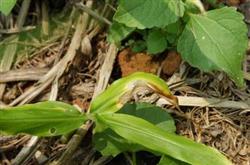Ginger planting techniques: what is Dioscorea zingiberensis stem rot?

What is turmeric stem rot? Please introduce and control the characteristics of turmeric stem rot: turmeric stem rot is a fungal disease caused by Fusarium. The fungus was saprophytic in the soil for a long time, spread by water flow and tillage, and invaded through the root wound or directly from the branch crack and the crack at the base of the stem of the aging seedling. During the growing period, the disease was serious in the fields with heavy rain, high humidity, high temperature, extensive management and poor ventilation. At the initial stage of the disease, waterlogged disease spots of different sizes appeared on the stem near the ground surface, and then gradually expanded. In the later stage, the disease spot ringed the stem base for a week, the subcutaneous tissue was loose and black, gradually rotted, the aboveground stems and leaves blackened, the stems withered and died, but did not fall leaves. The main results are as follows: (1) in terms of tillage methods, the disease is serious in the land where turmeric is planted for a long time, otherwise, it is mild. Second, the disease in paddy field and flat dam land is serious, while that in sloping land is light. Third, the incidence of ridge cultivation is mild, while that of flat planting and non-planting is serious. (2) rational application of phosphorus, potash fertilizer, boron and zinc and other micro-fertilizer plots with mild disease. (3) Dioscorea zingiberensis is resistant to drought, fertilizer, water and waterlogging, so the disease is serious under the conditions of high temperature and humidity, poor ventilation and moisture retention, and vice versa. Comprehensive control countermeasures of turmeric stem rot: according to the occurrence characteristics of turmeric stem rot, the principle of agrotechnical measures and chemical control were adopted. Through the selection of disease-resistant varieties, rational fertilization, crop rotation, high border and ridge cultivation, combined with chemical control, the stem rot of turmeric was effectively controlled. The main results are as follows: (1) choose disease-free and mildew-free seed potato to ensure that the whole seedling is strong. When sowing, use 200 grams of carbendazim for every 100 kg of seeds, add 100 kg of water, soak the seeds for 4-5 minutes, and wait for sowing after drying. (2) when preparing the land with serious disease, 70% topiramate, 50% carbendazim, 50% dimethazone or 1: 1.5 kg of fine soil mixed with 30 kg of fine soil should be sprinkled per mu. Disinfection with lime in acid soil can prevent soil-borne diseases. (3) rotation with Gramineae crops for more than 2 years. (4) apply mature farm manure, increase soil organic matter, improve soil, re-apply phosphorus and potassium fertilizer, skillfully apply boron and zinc fertilizer to enhance plant disease resistance. General mu application of farm fertilizer 15002000 kg, phosphate fertilizer 50kg, potash fertilizer 25kg or turmeric special fertilizer 75kg 100kg, mainly base fertilizer. (5) Ridge cultivation can improve soil ventilation and promote the growth of underground stems. The ridge is made according to 1 meter width, and the ridge height is 20 centimeters. when the seedling height is 30 centimeters, the "human" frame is built according to 4 bamboo poles per square meter to promote ventilation, light transmission and moisture flow, promote leaf photosynthesis, prevent and control diseases. (6) timely drug control, at the initial stage of the disease, choose 1000 times solution of 75% chlorothalonil, 50% carbendazim, 50% topiramate and 86.2% copper master 500 times 800 times solution, irrigate the root at the affected site, each plant is irrigated 50 × 100ml, once every 10 days, twice in a row. Click to get more ginger planting techniques click to get more vegetable planting techniques
- Prev

Ginger Planting Technology: What is Ginger Blast?
What is ginger plague? Please give details of ginger blast is caused by Pseudomonas solanacearum bacterial disease. Once the disease occurs in ginger field, it will reduce yield in light and no yield in serious. In recent years, the disease has become more serious year by year, and has become an important factor restricting the production of ginger. After years of research and field...
- Next

Ginger planting technology: how to apply fertilizer during the ginger expansion period?
How to fertilize ginger during the expansion period? Please give guidance at the end of July and the beginning of August, ginger nuggets enter the expansion period, which is the most critical period for yield formation. If the nutrient supply is insufficient at this time, it will affect the ginger bulge, make the ginger pieces thin and not full, and the yield will decrease obviously. Therefore, it is necessary to strengthen fertilization management during the ginger expansion period.
Related
- Where is it suitable to grow horseradish in China? it is expected to see the middle altitude horseradish in Alishan.
- How to prevent tomato virus disease reasonably? (Control methods included)
- Many people like to plant towel gourd on the balcony. What are the main points of this method and management?
- What crops can chili peppers be mixed with?
- Fertilization techniques and matters needing attention in Tomato
- What are the grafting techniques for peach seedlings in spring?
- Harm and control methods of root swelling disease of Chinese cabbage
- What are the pests of sweet potatoes? How to prevent and cure it?
- Symptoms, causes and Control methods of navel Rot in Tomato
- The cause of "Cucumber rotten bibcock" in Farmers' planting Cucumber and its Control Plan

